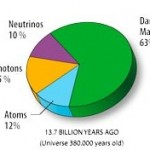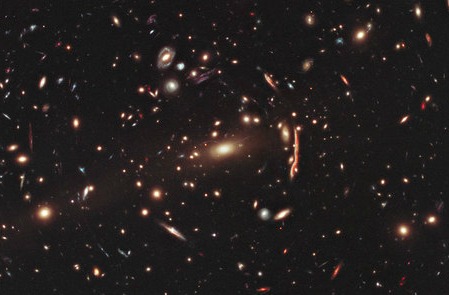Hubble is still out there of course, taking brilliant shots of a breathtaking universe (Below). One of the things the world’ most famous telescope will hopefully illuminate, in what’s left of its operational life, includes one may well be one of the most important mysteries in the universe: Dark Matter distribution:
To find out where dark matter lies, and how much of it there is, scientists look for an effect called gravitational lensing. This bending of light is caused when mass — including dark matter — warps space-time, causing light to travel a crooked path through it. The end effect is a curvy, funhouse-mirror type view of distant cosmic objects.
You might wonder why Dark Matter is so important, especially since it stays so diffuse, whereas the ordinary stuff clumps up in gas, dust, and stars, turning hydrogen and helium into carbon and oxygen, making rocky planets, butterflies and humans possible.
Does it clump? That’s a damn good question. Alas, since the fundamental nature of Dark Matter is unknown, no one can really say. But given that the dark stuff outnumbers the ordinary stuff by a huge factor, if it did clump we’d expect there to be way more dark matter objects with the masses of asteroids, planets and stars than there are actual asteroids, planets and stars. Since Dark Matter reacts just fine with ordinary matter under the force of gravity, tons of dark bodies should be readily detectable and we see no such thing anywhere we should be able to detect it.
So our present, very poor understanding, is that Dark Matter particles are not analogues to atoms, or even hadrons like proton and neutrons. Dark Matter analogues are probably more like electrons and quarks, for lack of better term, with one huge different: electrons and quarks readily combine to form bigger structures, i.e., atoms. And atoms have properties that allow them to clump together into really big and sometimes incredibly complex structures: they combine chemically, they radiate photons, and they fuse, and those are ways they can cool down.
The first is pretty obvious, we all learn the periodic table in high school, I hope anyway to the best of our knowledge there are not Dark Matter atoms or molecules. The part about cooling off is a little more subtle. Hot particles are zipping around, fast, that’s the very definition of hot on the particulate scale. But extremely hot, ordinary nuclei can still stick together via fusion, and merely warm ones can radiate energy with photons. Without those properties what might happen? They’d just smack into each other and bounce away, or, if we’re limited to quarks and electrons, they’d never hit each other and just pass by. The more you tried to crowd them together the more they’d try to expand because they can’t shed velocity. It wouldn’t take long before a point of diminishing returns was reached no matter how great the compressing force.

Dark Matter may not have the ability to cool or combine, and so the individual particles can’t do much in the way of aggregating unless they’re caught by gravity, or slowed through extraordinarily rare interactions with normal matter. Hence, we have a universe full of stars made of atoms, not collections of neutralinas. At least, that’s one conjecture.
What would this unseen dark universe be like today? Well, little changed form what it was a long time ago actually. The closest ordinary matter equivalent wouldn’t be gas, or even plasma, it would be the state of the ordinary matter universe moments after the Big Bang after quarks and electrons existed, but before they begin combining into hadrons and atoms. The Dark Matter universe, at least in this scenario, is like a primeval leftover of the unimaginably hot quagma that came and went like lightning at the dawn of time. It’s been stretched out and diffused with expansion over billions of years, but each one of these things in the galactic cloud exits in a blistering fast, individual orbit on the order of thousands of miles a second. They’re still “hot as hell”.
Of course there is one object that would serve to concentrate Dark Matter, the cores of stars and the black-holes those cores sometimes turn into. No matter how evasive the dark stuff might be, they can get stuck through weak interactions in stellar hearts and if they end up in a black-hole they’re stuck like anything else. And that brings up an interesting idea: the density of Dark Matter would have been way, way higher in the early universe. When the first VEMOs morphed into stellar mass black-holes there would have been plenty of the dark stuff around to feed them (And those particles would have been hauling ass carrying relativistic mass to boot). It’s possible that that would enable those early black-holes to grow much larger, much faster, either directly through falling in, or indirectly by increasing the mass of early stars that turned into or were consumed by the growing black-hole. How much this could have aided black-hole “precipitation,” which is theorized to have formed the spine of the earliest galaxies, is a great research topic: it seems those early, super-massive black-holes are a big part of the reason galaxies formed the way they did, and of course without galaxies there are no second and third generation stars, thus no rocky planets, and therefore no people and no butterflies who happen to live on one of them.
So yeah, Dark Matter distribution is a big deal, this stuff dominates the universe today and may have bent the arc of cosmic history as much or more than anything else we know about in ways we are only just now beginning to investigate. It’s a lead-pipe cinch we wouldn’t be here without it. Not bad for stuff that doesn’t even directly interact with the stardust below our feet, or the stardust pumping through our veins.


Leave a Reply
You must be logged in to post a comment.